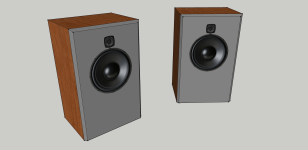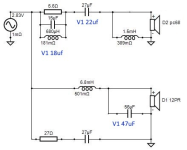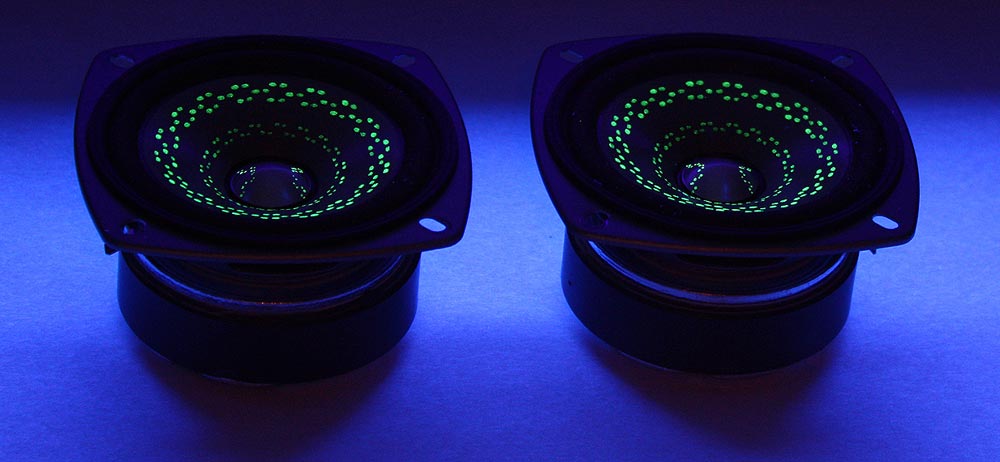I’d love to see the community develop a new modern WAW together.It would be prudent to develop a WAW system featuring easily accessible and affordable drivers, adopting a design that resonates universally, much like the widely popular Frugel-horn of the past decade.
I’d see the primary goals as:
<500hz crossover.
1/4 wavelength distance CtC spacing
Good directivity to 14k+
In room Bass extension to 35hz.
Nice to have goals:
<300hz crossover
85+ db sensitivity
Passive crossover (low tuned crossovers are expensive!)
Time aligned (separate enclosures?)
<30L - Bookshelf sized or <30hz extension and floor stander sized (or both options?).
Good diffraction box profile
Low THD for both drivers
I’d assume we’d use a 2-4” fullrange on top & a 6-10” driver on the bottom?
Does something like the GRS PT6816-8 planar tweeter technically count as a WAW? It can be crossed at 500hz?
Last edited:
I just finished a conversation with a prospective buyer for a pair of Aerial by Scanspeak sub drivers I list for sale. He was interested enough, until I told him they are rated to 29 hz solid in a smallish sealed enclosure, but by their qts are likely intended for a ported enclosure.Mitch333
He then got pretty near angry, and informed me he couldn't possibly use any sub that doesn't rate to 14 hz.
I was puzzled, and told him my room is 25 feet long, and any waves below 50 hz or so would be mashed up into pressure, and I doubted I'd be able to detect anything any woofer was playing below that, besides a tone toneless pressure. Am I wrong?
Marketplace immediately informed me to check my listings for false information.
Not directly related to the gist of your post, but the 50 hz jumped out at me seconds after a Marketplace admonition.
Makes you wonder doesn't it. Like you're to blame for the drivers characteristics.He then got pretty near angry, and informed me he couldn't possibly use any sub that doesn't rate to 14 hz.
jeff
Last edited:
Don't even need a double chamber, the original that Scott's is based on: Double Driver Dynamic Loading for Low Q Drivers (DDDQLLQD)I've been investigating MarkAudio drivers & I'm itching to try a design. It occurred to me that a 4" driver (like the inexpensive CHR-70) mated with a low cost high efficiency 6" or 8" bass driver could simultaneously achieve baffle step compensation & relieve the load on the 4" driver, when crossed over at the baffle step frequency. A double chamber bookshelf style box is required, no biggie. The crossover could be fairly simple too. Has anyone published a DIY design along these lines? Thanks in advance!
A wee bitI was puzzled, and told him my room is 25 feet long, and any waves below 50 hz or so would be mashed up into pressure, and I doubted I'd be able to detect anything any woofer was playing below that, besides a tone toneless pressure. Am I wrong?
 , ~1128.61/2/25 = ~22.57 Hz before any significant rising room gain assuming its construction isn't too lossy, though how well one can hear it will depend on how much louder it is than the mid band and how wide the instrument's BW, i.e. the higher its harmonics we hear the lower the perceived fundamental.
, ~1128.61/2/25 = ~22.57 Hz before any significant rising room gain assuming its construction isn't too lossy, though how well one can hear it will depend on how much louder it is than the mid band and how wide the instrument's BW, i.e. the higher its harmonics we hear the lower the perceived fundamental.I’d love to see the community develop a new modern WAW together.
Assume we’d use a 2-4” fullrange on top & a 6-10” driver on the bottom?
Does something like the GRS PT6816-8 planar tweeter technically count as a WAW? It can be crossed at 500hz?
Those planar drivers do look fun.
I would say yes very possible. Only played with the driver
in sim 600 Hz / 800 Hz was more feasible for low crossover.
A complicated crossover was needed for the PT5010
to flatten it out. Im not a huge open baffle fan. But the common
peak seen with open baffle would actually be helpful with the GRS
planars. But 500/600 Hz likely more possible with 5010
Far as cone drivers, center to center spacing with a 2" or 2.5" driver
can be very very close. And the behavior even in vertical seems to be
rather impressive. 14k off axis with would be tough because of the
physical size of the cone. Most 2 ways end up becoming 3 ways if high end
is a goal. Great thing again though is 2.5" driver also offer very tight
center to center for a very small tweeter. 3/4" is possible
and with neo magnets. Large mounting frames/magnets
go away and further improve center to center.
Getting over 85 dB would depend on drivers, It is really the only drawback
is the efficiency of small Wideband drivers tend to be low. And baffle
compensation would make it even lower. All good, part of the tradeoff
for such wonderful potential of tight center to center
Sim and posted concept for a WAW with cheapo drivers and rather large
cabinet for deep bass, but uses high Qts driver sealed
12" and 2.5"
With baffle compensation and efficiency of 2.5" driver
82 dB.

Attachments
Last edited:
I'm not jumping to conclusions without hearing for myself first. Circular drivers are likely to have an uncontrolled mode of vibration resembling a spinning coin. As one side of the voice coil moves into the magnetic gap, the opposite side moves out, so there's no electrical damping.Little 'squiggly patterns' put on speaker cones for 'psychoacoustic effect' doesn't really inspire me
These sort of rings look like they would make the mechanical impedance of the cone surface anisotropic. So, in a simple axial direction from coil to surround, there are just small 'blips' -- a thin layer of mass. But in a circular direction, there is a long transmission line of masses.
Some PA or high efficiency drivers have similar looking concentric rings, which makes the stiffness anisotropic, but that would alter the frequency of break-up modes rather than the damping.
Last edited:
I'm not jumping to conclusions without hearing for myself first.
Trust your ears. Beware your brain.
dave
Do you think it’d be possible to add a 3D printed backplate or a small box to these and close them up?Those planar drivers do look fun.
I would say yes very possible. Only played with the driver
in sim 600 Hz / 800 Hz was more feasible for low crossover.
I’d love to have an open baffle but my listening environments don’t really work with the spacing they by all accounts need.
1125 feet÷ 50 hertz= a 22.5 hertz wave.A wee bit, ~1128.61/2/25 = ~22.57 Hz before any significant rising room gain assuming its construction isn't too lossy, though how well one can hear it will depend on how much louder it is than the mid band and how wide the instrument's BW, i.e. the higher its harmonics we hear the lower the perceived I've always used 1125 feet per second for the sake of ease in calculating wavelengths.
You're talking about room pressure gain, which I think only you mention. I mentioned an undistorted wavelength fitting in a room.
I've heard 25 hertz from more than 50 feet away from a subwoofer. In a room enough to be as long as the wavelength, it has a distinct tone. In a room that's shorter than the wavelength, you are correct- it's only pressure. You multiple question marks indicate your confusion about the difference between your number for the speed of sound and a nominal number like mine. Let me clear that up for you. Standard temperature and pressure. The temperature and therefore pressure of the atmosphere vary according to elevation, time of day, and time of season. So no, I don't obsess about a 0.03% or less difference between a nominal number like mine, and yours, which is only avcutate6ar sea level, 20° Celsius, and about 101 Pascale atmosphere pressure. I don't live in these conditions, nor do I place my speakers there. Thanks anyways though.
I've heard 25 hertz from more than 50 feet away from a subwoofer. In a room enough to be as long as the wavelength, it has a distinct tone. In a room that's shorter than the wavelength, you are correct- it's only pressure. You multiple question marks indicate your confusion about the difference between your number for the speed of sound and a nominal number like mine. Let me clear that up for you. Standard temperature and pressure. The temperature and therefore pressure of the atmosphere vary according to elevation, time of day, and time of season. So no, I don't obsess about a 0.03% or less difference between a nominal number like mine, and yours, which is only avcutate6ar sea level, 20° Celsius, and about 101 Pascale atmosphere pressure. I don't live in these conditions, nor do I place my speakers there. Thanks anyways though.
Last edited:
Keeping things simpleDo you think it’d be possible to add a 3D printed backplate or a small box to these and close them up?
I’d love to have an open baffle but my listening environments don’t really work with the spacing they by all accounts need.
would be my preference as well.
Yes just a otherwise normal wood midrange
chamber like conventional cone speakers.
My approach be somewhat large as possible
and just use normal everyday absorption material.
Like poly fill and stuff it.
Probably be fun to start a separate concept thread.
I have played with a feasible passive crossover for
the planar / with the RS225 8" woofer.
I tend to use wide baffles, but could state your
preferences for baffle size and woofer.
And design a starting point for crossover.
Very much so improve clarity of the wideband. CHR-70 has a response anomaly around 500 Hz if I remember.It occurred to me that a 4" driver (like the inexpensive CHR-70) mated with a low cost high efficiency 6" or 8" bass driver could simultaneously achieve baffle step compensation & relieve the load on the 4" driver, when crossed over at the baffle step frequency.
So a 6.5" or newer 7" woofers have enough bandwidth to likely really clean up things and get a nice response.
I would tend to lean towards a 8" or 10" woofer to really wake up the low end.
But understandable for a smaller bookshelf type form factor. I think 6.5"
or even newer more modern drivers which are around 7". Would make very
good bass. They have Woven Fiber cone / Neo drivers in 7" range. Which
keeps them affordable, but good performance.
Hi,
I would just like to jump in -while I hope I do not interrupt the discussion- with some questions.
I have eminence alpha 15a on open baffles which are now 0.5x1m big. It is experimential baffle as I already did some trials with open baffles, front horns and some other types of box types in the very past as well. I came back to the hobby after some 7years of not listening to music or anything at all... Well the place where I am now allows open baffle approach and I bought the used alphas. They do already well on the baffles and some 3m away from them I can hear some 40-50hz bass and that is enough. I have a simple grundig V4200 mk2 amp and no source for now but the pc. As I said no music or machines for many years. There are other worlds...
Anyway, I am looking now for a driver above the 15a and would like not to use any compensation circuits but simple passive crossovers. I am asking for the advice because of the sensitivity (which manufacturers parameters cannot be fully trusted). I know many of you started from the old melhuish forum (fullrange forum I think) and get on with many types of loudspeakers and systems... I am asking for the experiential advice: would some of this drivers work well (crossover as low as possible 200hz maybe, 2nd order and no resistors fro lowering the efficiency):
these are the candidates within the budget
faital pro 4fe42 8ohm -or is sensitivity too high to match with alphas on OB?
(there are also the 3" but I don´t know if they can handle low crossover points faital 3fe and Beyma 3fr30v2)
mark audio chr 70 or better (because I am keen to a paper, had some alu drivers): pluvia 7p
then the more expensive (here the problem arises as for this cost we are already in the area of coaxials also)
visaton b60 or b100
and at last, never tried but heard them and really like the sound of them, even on simple videos, planars:
GRS pt 6825-8
What would be the bigger sound differencies between those drivers acording to the music, for example difficult for FR are usualy mass of violins as the treble becomes more strident than with normal 3way speakers where the operating range is divided-less ringig, beaming and so on. Or compression in the lower mids? For 50€ per peace you can get many speaker drivers even 8" fr from SB or even some coaxes (5,6"). I am not aiming for perfect extremes but more for whta would play on OB above alphas that could stand some test of time. Usually drivers that are somewhat indistincitve by first comparisons with other more prominent win on longer run beacuse they show less fatigut (by my ears tha menas lowwr peaks un downs, softer, lets say more rounded sound but with great resolution...). Well I am getting lost. I am alread thankful in advance for your time and experiences. You know better with what drivers you sticked for longer time even if there is no answer to the why.
regards
tine
I would just like to jump in -while I hope I do not interrupt the discussion- with some questions.
I have eminence alpha 15a on open baffles which are now 0.5x1m big. It is experimential baffle as I already did some trials with open baffles, front horns and some other types of box types in the very past as well. I came back to the hobby after some 7years of not listening to music or anything at all... Well the place where I am now allows open baffle approach and I bought the used alphas. They do already well on the baffles and some 3m away from them I can hear some 40-50hz bass and that is enough. I have a simple grundig V4200 mk2 amp and no source for now but the pc. As I said no music or machines for many years. There are other worlds...
Anyway, I am looking now for a driver above the 15a and would like not to use any compensation circuits but simple passive crossovers. I am asking for the advice because of the sensitivity (which manufacturers parameters cannot be fully trusted). I know many of you started from the old melhuish forum (fullrange forum I think) and get on with many types of loudspeakers and systems... I am asking for the experiential advice: would some of this drivers work well (crossover as low as possible 200hz maybe, 2nd order and no resistors fro lowering the efficiency):
these are the candidates within the budget
faital pro 4fe42 8ohm -or is sensitivity too high to match with alphas on OB?
(there are also the 3" but I don´t know if they can handle low crossover points faital 3fe and Beyma 3fr30v2)
mark audio chr 70 or better (because I am keen to a paper, had some alu drivers): pluvia 7p
then the more expensive (here the problem arises as for this cost we are already in the area of coaxials also)
visaton b60 or b100
and at last, never tried but heard them and really like the sound of them, even on simple videos, planars:
GRS pt 6825-8
What would be the bigger sound differencies between those drivers acording to the music, for example difficult for FR are usualy mass of violins as the treble becomes more strident than with normal 3way speakers where the operating range is divided-less ringig, beaming and so on. Or compression in the lower mids? For 50€ per peace you can get many speaker drivers even 8" fr from SB or even some coaxes (5,6"). I am not aiming for perfect extremes but more for whta would play on OB above alphas that could stand some test of time. Usually drivers that are somewhat indistincitve by first comparisons with other more prominent win on longer run beacuse they show less fatigut (by my ears tha menas lowwr peaks un downs, softer, lets say more rounded sound but with great resolution...). Well I am getting lost. I am alread thankful in advance for your time and experiences. You know better with what drivers you sticked for longer time even if there is no answer to the why.
regards
tine
- Home
- Loudspeakers
- Full Range
- Markaudio: has anyone designed something like this?



